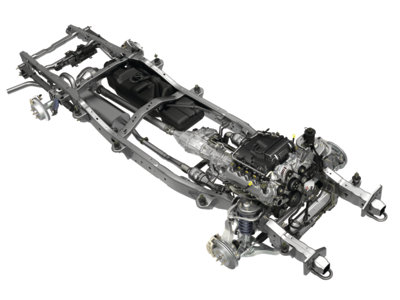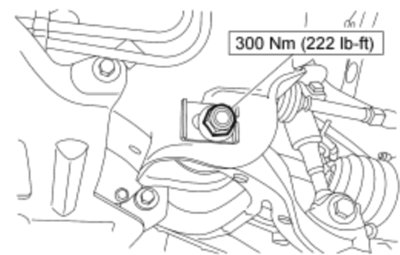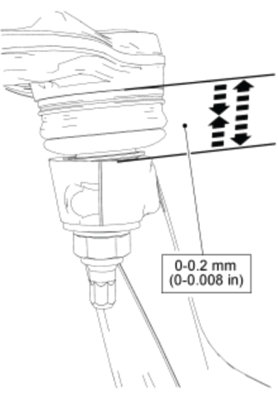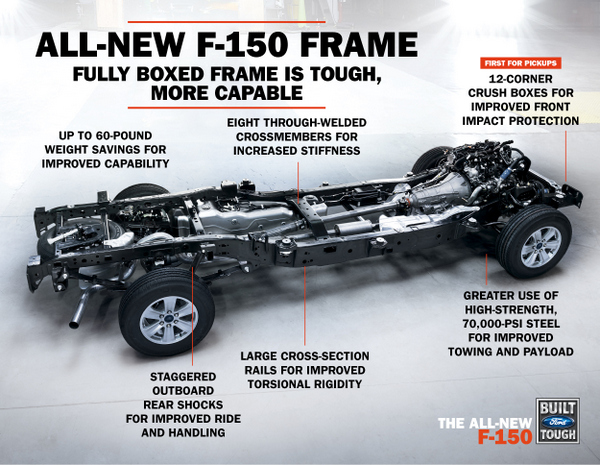The 2004-’08 Ford F-150 and 2005-’08 Lincoln Mark LT are not difficult vehicles to align, but they are difficult vehicles to properly inspect and adjust to the optimal specifications.

The 11th generation F-150 was a completely new platform for 2004. There are 2004 models of the old platform known as “heritage” or “classic” F-150s. The main difference with the 11th generation is in the front control arms. The lower control arm is forged aluminum. Upper ball joints have a reputation for failing sooner than lower ball joints.
To adjust camber and caster, you must install cam bolts in the lower control arms. By installing the four bolts, you can get ±2.0º of camber and caster.
The caster should be measured and adjusted with the truck loaded with the average payload. If you do not take into account the extra weight, the caster may turn too positive when the customer loads the bed up with tools and supplies. This could cause the customer to complain about increased steering effort. If the caster is excessive, it is an opportunity to sell the customer on springs and ride-leveling products.
The base tire package on an F-150 starts at 17 inches. This can be a very expensive tire. If excessive cross-tolerances of the camber or the toe are near specifications, the edges of the tires may feather or wear. Take your time and make sure all the adjustments are deep into the green.

Always measure the thrust angle. The thrust angle is a diagnostic angle. Failing to do this can lead to a misaligned steering wheel and tire-wear problems.
Camber & Caster Adjustments
1. New lower arm-to-frame mounting bolts must be installed with cam bolt kits to allow for adjustment of the arm in the frame slot. The rear lower control arm-to-frame bolt must be reversed in order to install the alignment kit to allow access for a torque wrench. You should not have to remove the sway bar for some aftermarket bolt kits. Check the instructions before you begin.

2. To adjust the caster and camber, refer to the chart on page 16.
Adjustments that require moving the front and the rear of the lower arm should be made equally. Check cross camber and caster tolerances after the adjustment.
3. While holding the bolt, tighten the nut.
4. Check and, if necessary, adjust the front toe.
5. Set the final torque to 300 Nm (222 ft.-lb) on the nuts only.
Ball Joint Inspection
When performing a pre-alignment inspection, always check the ball joints for wear. The inspection needs to be performed with the suspension unloaded and in the full rebound position. The weight of the wheel and tire assembly must be overcome to obtain an accurate measurement on the dial indicator.
Inspect the ball joint for relative movement by alternately pulling downward and pushing upward on the wheel and tire assembly by hand. Note any relative vertical movement between the wheel knuckle and lower arm at the lower ball joint.
If relative movement is not felt or seen, the ball joint is OK. Do not install a new ball joint. If relative movement is found, you need to measure the movement with a dial indicator. To measure ball joint deflection, attach a suitable dial indicator with a flexible arm between the lower control arm and the wheel knuckle or ball joint stud. The joint should have less than 0.2 mm of deflection.

Quick Tips
• On the “new” model F-Series trucks, be sure to fold the side view mirrors in when raising these trucks on a two-post lift. The mirrors are large enough that they have been crushed by the plate or cap found at the top of lift posts.
• This one issue might seem excessively simple to talk about, but can be very embarrassing in front of the customer if you are not prepared. The secondary hood release handle was moved on the 2008 Super Duty. It is now below the inside lower corner of the right headlight.
The Truck in a Beer Can: The 13th generation Ford F-150
Last month, Ford unveiled the latest generation of the Ford F-150. The new F-150 is up to 700 pounds lighter, helping the truck tow and haul more, accelerate and stop faster, and operate more efficiently. The main area of weight reduction is the body. The body uses high-strength, military-grade, aluminum alloys to make the new truck’s body lighter, stronger and more resistant to dents.
The frame is still steel, but the lower control arms are stamped steel and not forged aluminum. The aluminum control arms were not carried over to the 13th generation F-150.
Ford is introducing a suite of smart driver-assist technologies on a pickup for the first time, including lane-keeping assist, adaptive cruise control and a collision mitigation system.
Lane-keeping assist uses the truck’s front camera system to monitor lane markings and can alert the driver if the vehicle drifts out of its lane — even providing steering torque to pull it back into the center of the lane if needed.
These new technologies will not work if the new F-150 is not aligned properly and the steering position sensor is malfunctioning after the alignment.















